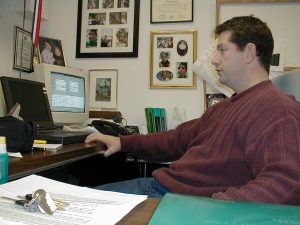
I began the move toward a paperless office more than 20 years ago. Back then I operated a 5 person inter-discipline office with technology dominated by cables running from one machine to another. I was the the firm owner as well as the ‘technology guy’ by virtue of my early adoption of PC technologies1. By 2003, paper files were mostly just backup for us and an added burden that I had to move from one office to another when I occasionally relocated. Work flow was still controlled by PC-based applications and operating systems that could occasionally break down. It wasn’t until 2014 that I resolved to be completely free of all hardware restrictions. By January 1, 2015 I was finally able to walk up to any machine or pick up any device, anywhere in the world, and conduct my professional business practice while knowing that my private and professional data was never more secure. I didn’t recognize it at the time but my small firm was one of the pioneers in this movement. My change was driven by equal doses of laziness and vision. The vision was that I wanted to work from a home office in the front bedroom of my shore house in Ocean City, NJ. The laziness was that I did not want to carry files back and forth. A scanner and a shared hard drive got me started. The technologies have come a long way since then.
I sometimes lament that the capabilities of today’s software has actually taken a step back from the tools of those early days. Our need for a higher level of privacy and data security has limited some data access and the need to monetize technical services has caused some technologies to disappear. Remember when we could actually plug a phone line into our computer or directly watch real broadcast television on a computer screen? In those days it was also possible for almost anyone to reach vast amounts of data through unrestricted searches of information that is protected by high levels of security and firewalls today that keep away prying eyes.
My path to a paperless office certainly took a few wrong turns that led to dead ends. Blackberry technologies and other proprietary software that went out of business cost me time and money but led to firm management principles that allow me to be more confident of this path today.
Now I take notice when a firm is still operating based on paper files. They typically share a range of common complaints and horror stories of missing files and scrambling to find documents when a client calls. I’ve been able to help with their modernization mostly by offering assurance that the conversion process really does work.
Today most conversations on paperless operation focus on the level of security of the platforms we use. These are valid concerns but the discussions are theoretical. The fact is that we don’t know about vulnerabilities until after the fact of a breach or failure. Again, the adoption and maintenance of sound overriding firm data management principles is the best approach to a winning business model for the years ahead.
I’m happy to share some of the many things I’ve learned along the way with other professional firms that are making the transition today.
1 I learned basic computer programming from the single Wang computer in my high school in the 1970s. I was fortunate to have access to the $4,000 plus that it cost to buy one the earliest IBM PCs as a graduate business student in 1982. I used that machine to write stock market behavioral programs based on the Black Scholes formula with my Temple University finance department professors and peers that collectively with many other became known as “basket trading”. Eventually this led me to launch of an internet-based insurance and employee benefits business in 1995 called MedSave. Being a pioneer in technology created both advantages and disadvantages to my career. Somewhere around the middle 2000s I made the deliberate choice to slow down to the middle of the technology curve for the sake of more reliable professional work flow.

Leave a Reply